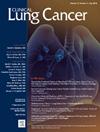计算机辅助结节分析和风险产率与临床I-IIA期肺腺癌切除的隐匿淋巴结状态相关
IF 3.3
3区 医学
Q2 ONCOLOGY
引用次数: 0
摘要
背景:目前的分期检查并不能捕获所有的隐匿性淋巴结(OLN)疾病。我们试图确定计算机辅助结节分析和风险收益(CANARY)分析是否有助于区分早期肺腺癌的OLN状态。方法:回顾性分析2016 - 2021年肺癌切除术患者。包括手术切除的临床I-IIA期肺腺癌患者。术前影像学输入CANARY软件,将每个病变分为好、中、差风险。根据病理结果确定OLN状态。采用Pearson卡方相关、单因素和多因素logistic回归模型评估OLN转移作为CANARY风险谱的函数,差异均有统计学意义(α=0.05)。结果:研究队列共纳入228例患者,中位年龄为70岁。根据临床分期,分别有195例(85.5%)、24例(10.5%)和9例(3.9%)患者被确定为IA、IB和IIA。28例(12.3%)患者发现OLN转移。其中,1例(3.6%)、3例(10.7%)、24例(85.7%)患者具有良好、中度和较差的CANARY风险特征。CANARY风险谱与OLN转移显著相关(χ2 = 9.9, P = 0.007)。相对于良好/中等风险组,低风险患者发生OLN转移的可能性增加3倍以上(奇比[OR] = 3.3, 95%可信区间[CI]:1.6-9.2, P = .007)。结论:CANARY分析能够对早期肺腺癌中OLN转移的可能性进行风险分层。CANARY可以提供一种辅助的非侵入性工具,以帮助确定适当的个体化治疗计划。本文章由计算机程序翻译,如有差异,请以英文原文为准。
Computer Assisted Nodule Analysis and Risk Yield is Associated With Occult Lymph Node Status in Clinical Stage I-IIA Lung Adenocarcinoma Undergoing Resection
Background
Current staging work-up does not capture all occult lymph node (OLN) disease. We sought to determine if Computer Assisted Nodule Analysis and Risk Yield (CANARY) analysis could help distinguish OLN status in early-stage lung adenocarcinoma.
Methods
Retrospective review of resected lung cancer patients from 2016 to 2021 was performed. Patients with surgically resected clinical stage I-IIA lung adenocarcinoma were included. Preoperative imaging was entered into the CANARY software, and each lesion was categorized into good, intermediate, and poor risk. OLN status was determined per pathology results. Pearson's Chi-square correlation, univariate and multivariate logistic regression models were used to assess OLN metastases as a function of CANARY risk profile, with statistical significance at .
Results
In total, the study cohort included 228 patients with median age of 70. By clinical stage, 195 (85.5%), 24 (10.5%), and 9 (3.9%) patients were determined to be in IA, IB, and IIA, respectively. 28 (12.3%) patients were found to have OLN metastases. Among them, 1 (3.6%), 3 (10.7%), and 24 (85.7%) patients had a good, intermediate, and poor CANARY risk profile, respectively. CANARY risk profile was significantly associated with OLN metastases (2 = 9.9, P = .007). Relative to the good/intermediate group, patients with poor risk had a more-than 3-fold increase in likelihood of having OLN metastases (odd ratio [OR] = 3.3, 95% confidence interval [CI]:1.6-9.2, P = .007).
Conclusion
CANARY analysis was able to risk-stratify the likelihood of OLN metastases in early-stage lung adenocarcinoma. CANARY can provide an adjunctive non-invasive tool to aid in determining an appropriate individualized treatment plan.
求助全文
通过发布文献求助,成功后即可免费获取论文全文。
去求助
来源期刊

Clinical lung cancer
医学-肿瘤学
CiteScore
7.00
自引率
2.80%
发文量
159
审稿时长
24 days
期刊介绍:
Clinical Lung Cancer is a peer-reviewed bimonthly journal that publishes original articles describing various aspects of clinical and translational research of lung cancer. Clinical Lung Cancer is devoted to articles on detection, diagnosis, prevention, and treatment of lung cancer. The main emphasis is on recent scientific developments in all areas related to lung cancer. Specific areas of interest include clinical research and mechanistic approaches; drug sensitivity and resistance; gene and antisense therapy; pathology, markers, and prognostic indicators; chemoprevention strategies; multimodality therapy; and integration of various approaches.
 求助内容:
求助内容: 应助结果提醒方式:
应助结果提醒方式:


